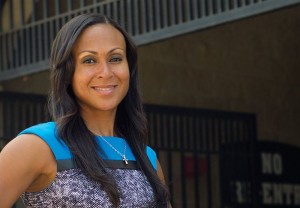 A new book by a University of Texas at Arlington sociologist offers new insight into how sports alter and reflect the way we view the world when it comes to modern race relations.
A new book by a University of Texas at Arlington sociologist offers new insight into how sports alter and reflect the way we view the world when it comes to modern race relations.
In “The Enduring Color Line in U.S. Athletics,” assistant sociology professor Krystal Beamon assembles findings from previous research, data from the NCAA and interviews with professional athletes to explore sports as a social construction. The book is part of the academic series, Framing the 21st Century Social Issues and is published by Routledge. Chris M. Messer, assistant professor of sociology at Colorado State University-Pueblo, is the co-author.
Among the topics addressed is the difference between the way Hispanics are regarded in professional baseball compared with how Hispanic immigrants are regarded in society overall.
“There seems to be a concern about the growing overrepresentation of Hispanics in Major League Baseball and its farm system,” said Beamon, who joined the UT Arlington Department of Sociology & Anthropology in 2009. “While baseball’s ‘farming’ of Hispanic players from places like Puerto Rico and Venezuela has been great for the marketplace and has provided a new fan base, there is a fear that Hispanics may be ‘taking over’ the sport that reflects a larger societal concern over current immigration policies.”
Beamon, a former All-American sprinter for Oklahoma State University, said she was inspired to write the book after more than a decade of researching African-American males in elite athletics. Messer helped highlight the interconnection of race, access to sport, socialization and stereotyping.
“What makes this book unique is that we examine the distribution of several racial groups in a variety of sports at all levels and offer sociological explanations for their under- or over-representation,” Messer said. “Furthermore, we offer a glimpse into some of the experiences associated with these outcomes.”
The authors also looked at the under-representation of Native Americans in sports, its connection to institutional discrimination and the emotionally charged debate over sports teams with American Indian names, mascots and logos.
The issue of how Native Americans are regarded in sports gained renewed attention at the start of the 2013 NFL season when an American Indian tribe in upstate New York launching a campaign condemning the use of the word “Redskins” as a team name and mascot.
“For at least 40 years or more, Native Americans have said, ‘This is offensive,’ ” Beamon said. “Still, the most popular sports mascots in this country are beasts or birds of prey and Native Americans delineations. They are names and images that draw on the age-old stereotype of the savage, warrior Native American and they continue to play on that stereotype.”
Beamon said her work is intended to highlight the significance sports has in society, but also to draw the connection to race.
“The large majority of athletes in the NBA and NFL are African American, but the owners, coaches, sports doctors, trainers, and most of the decision-making positions are still widely held by white males,” she said. “This mirrors society in some ways and produces similar results.”
Beamon’s work is representative of research excellence at The University of Texas at Arlington, a comprehensive institution of more than 33,300 students and 2,200 faculty members in the epicenter of North Texas. It is the second largest institution in The University of Texas System. Total research expenditures reached almost $78 million last year. Visit www.uta.edu to learn more.





Comments are closed.